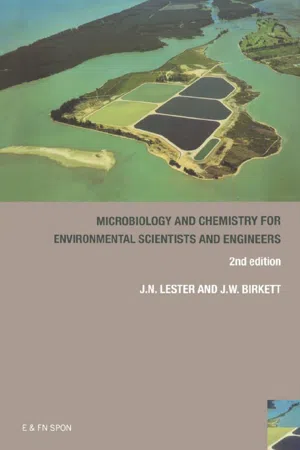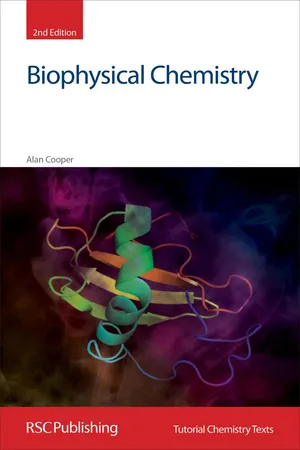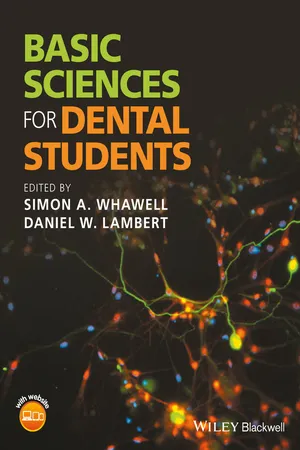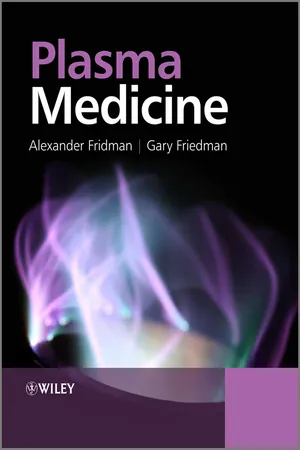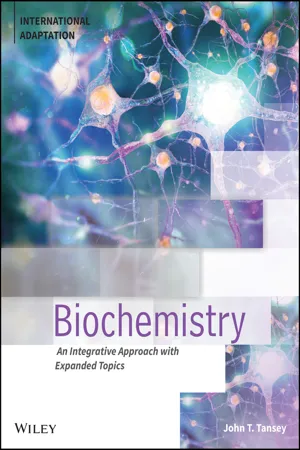Biological Sciences
Organic Molecules
Organic molecules are carbon-based compounds that are essential for life. They form the building blocks of living organisms and are involved in various biological processes such as energy production, growth, and reproduction. Examples of organic molecules include carbohydrates, lipids, proteins, and nucleic acids.
Written by Perlego with AI-assistance
Related key terms
12 Key excerpts on "Organic Molecules"
- Jason Birkett, John Lester(Authors)
- 2018(Publication Date)
- CRC Press(Publisher)
Chapter 8Biological molecules
8.1 Introduction
The existence of a cell depends upon its structural components, which maintain its physical integrity, and its functional components, which control its growth, metabolism and reproduction and which regulate these processes. In a great many instances structural and functional roles are closely integrated, even in the simplest cell.The highly ordered, but extremely complex nature of living cells is due to the great variety of organic compounds which may be formed, inherent in the chemical properties of carbon itself. Its ability to form four covalent bonds with other atoms and itself, generating long carbon chains, gives rise to an almost limitless number of possible compounds, including macromolecules with molecular weights as high as 100 million. In all cases, these macromolecules are formed from the linkage, in a series, of smaller molecules, termed monomers, and hence are called polymers. Even if constructed from a pool containing a relatively small number of different types of monomer molecules the number of different possible sequences of these subunits is theoretically very large indeed. If only a small fraction of all of the possible combinations of monomers were to be associated with a distinct structural or functional characteristic of the polymer molecule, this number would be more than sufficient to account for the enormous diversity and complexity of living organisms. There are, however, a large number of characteristics common to all cells, irrespective of their origins, which is indicative of a moderately consistent selection of only a few of the possible combinations in each case, suggesting that cellular chemistry is organized and regulated in a highly precise manner.There is, in addition to the macromolecules, a great variety of other organic compounds which are important by virtue of their role as nutrients and intermediary metabolites. However, this chapter focuses only on those which are unique and integral components of cells—the macromolecules.- eBook - ePub
- Alan Cooper(Author)
- 2015(Publication Date)
- Royal Society of Chemistry(Publisher)
1
Biological Molecules
You don’t need to know any biology in order to study biological molecules, but it does help to have some background.Aims This chapter will briefly review the bare bones of biological (macro)molecules. By the end, and together with your previous knowledge and some background reading, you should be able to:- Describe the basic chemical structures of polypeptides, polynucleotides, fats, lipids, and carbohydrates
- Explain what is meant by the primary, secondary, tertiary and quaternary structure of proteins
- Describe the behaviour of fats, lipids and detergents in water
- Explain the anomalous properties of liquid water
- Recall the fundamentals of acid–base equilibrium
1.1 Introduction
This book is mainly about the experimental methods used to understand the physical properties and function of the molecules that make up living systems.These molecules—proteins, polynucleotides, polysaccharides, lipids—are not necessarily any different from molecules we study in other branches of chemistry. But there are some additional factors, arising from their biological origin, which we need to be aware of.- Biological macromolecules are large molecules formed from many smaller units and are (usually) polymers of precise length and specific sequence.
- They (usually) fold or associate into specific conformational assemblies stabilized by non-covalent interactions.
- This (usually) happens in water.
- The molecules are the (usually) successful outcomes of biological evolution.
It is this last point that makes things so exciting for the biophysical chemist. The molecules we see today are the results of countless random (more or less) experiments over millions of years during which living systems have evolved to take advantage of subtle principles of physical chemistry that we barely yet understand. By studying such systems we can learn much about physical chemistry in general, with potential for applications in other areas. - eBook - ePub
- Simon A. Whawell, Daniel W. Lambert, Simon A. Whawell, Daniel W. Lambert(Authors)
- 2017(Publication Date)
- Wiley-Blackwell(Publisher)
1BiomoleculesDaniel W. Lambert and Simon A. WhawellSchool of Clinical Dentistry, University of Sheffield, Sheffield, UKLearning Objectives
- To understand the basis of molecular structure and bonding.
- To outline the basic structure and function of proteins, carbohydrates, lipids and nucleic acids.
- To be able to describe the biological role of enzymes and explain how their activity is regulated.
- To understand basic energy‐yielding pathways and how they are controlled.
Clinical Relevance
An understanding of basic biomolecule structure and function provides a foundation for all normal cell and tissue structure and physiology. The structure of biomolecules present in the human body closely relates to their function, as is the case for cells and tissues. In disease, drugs can be used that target specific biochemical pathways, so an appreciation of biochemistry underlies patient care as well as the diagnosis, prognosis and treatment of disease.Introduction
As complex as the human body is, it is heavily dependent on just four atoms for its composition: carbon, hydrogen, nitrogen and oxygen. These atoms form structurally diverse groups of biologically important molecules, their structure always relating to their function in the same way that the cells and tissues of the body are adapted. Biomolecules commonly take part in relatively simple reactions which are subject to complex control to finely tune the essential processes that they mediate. Biomolecules are often large polymers made up from smaller molecular monomers and even though there are thousands of molecules in a cell there are relatively few major biomolecule classes. Fatty acids, monosaccharides, amino acids and nucleotides form di‐ and triglycerides, polysaccharides, proteins and nucleic acids respectively. Small molecules are also important to biology, as we will see; adenosine triphosphate (ATP), for example, stores energy for catabolic and anabolic process and nicotinamide adenine dinucleotide (NADH) is the principle electron donor in the respiratory electron transport chain. - eBook - ePub
- Zoe Davies(Author)
- 2017(Publication Date)
- Wiley-Blackwell(Publisher)
Chapter 1 The Biochemical Nature of CellsBiochemistry is the study of chemicals within biology. A knowledge of biological molecules and their structure and function is essential for a full understanding of the nature, performance and behaviour of horses. There are approximately one hundred elements that exist on Earth; of these, 16 are essential for life and only four make up 95% of all living matter, namely carbon, hydrogen, oxygen and nitrogen.The combination of carbon with other elements creates a huge variety of Organic Molecules, and all organic compounds therefore contain a carbon backbone. The four main classes of Organic Molecules are proteins, carbohydrates, lipids and nucleic acids. In addition, a relatively small number of inorganic ions such as sodium and potassium are essential for life, as components of larger molecules or extracellular fluids. Table 1.1 shows examples of organic and inOrganic Molecules.Examples of organic and inorganic compounds in the horse's bodyTable 1.1Organic compounds Inorganic compounds Glucose (C6 H12 O6 ) Water (H2 O) Ethane (C2 H6 ) Ammonia (NH3 ) Glycine (amino acid) (C2 H5 NO2 ) Carbon dioxide (CO2 ) Cytosine (nucleotide base) (C4 H5 N3 O) Nitrate ion (NO3– ) Horses therefore contain water plus a huge number of macromolecules which have been built up from smaller simpler ones. These molecules are also involved in the basic structure and function of all cells (Figure 1.1 ). These simple building blocks are similar in all organisms, suggesting a common origin for all life forms.The biochemical nature of cells.Figure 1.1Metabolism
All chemical reactions that take place within the horse are collectively known as ‘metabolism’. Metabolic reactions can be anabolic (building up large molecules from smaller ones) or catabolic (breaking down larger molecules into smaller ones). Anabolic reactions usually involve removal of water molecules and are known as condensation reactions, such as when glycogen is built up from glucose molecules. Catabolic reactions are the reverse and usually involve larger molecules being split when reacting with water. These are known as hydrolysis reactions, for example digestion of proteins in the digestive system. - eBook - ePub
- Alexander Fridman, Gary Friedman(Authors)
- 2012(Publication Date)
- Wiley(Publisher)
In contrast to releasing energy in the form of heat, living systems often convert the energy of the redox reaction into other forms including electrostatic; this is the case in cellular respiration when electrons are transported across membranes of intracellular organelles (mitochondria). In fact, it appears that plasma treatment interacts with cells and tissues at least in part by directly or indirectly influencing redox reactions in cells and cellular respiration.3.1.2 Main classes of Organic Molecules in living systemsIn living systems there are four main classes of macromolecules that perform a variety of functions: (1) carbohydrates and sugars; (2) lipids (fats and oils); (3) polypeptides (proteins); and (4) nucleic acids.3.1.2.1 CarbohydratesCarbohydrates (synonymous with saccharides in biochemistry) consist of carbon, oxygen and hydrogen where the number of hydrogen atoms is about twice as large as the number of oxygen atoms which, in turn, is about the same as the number of carbon atoms. Carbohydrates are used for a relatively short-term and intermediate-term energy storage (starch for plants and glycogen for animals). They are also employed as structural components in some cells (cellulose in the cell walls of plants and many protists and chitin in the exoskeleton of insects and other arthropods).Sugars are structurally the simplest carbohydrates. They are the key building materials that make up other types of carbohydrates. Monosaccharides (see examples in Figure 3.3 ) are the simplest and smallest sugar molecules with a formula [CH2 O]n , where n is typically between 3 and 6. Some important monosaccharides include ribose (C5 H10 O5 ), glucose (C6 H12 O6 ), and fructose. We classify monosaccharides by the number of carbon atoms, the arrangement of atoms (molecules that have the same chemical formula but different atomic arrangements are called isomers) and the types of functional groups present in them. For example, glucose and fructose (illustrated in Figure 3.3 ) have the same chemical formula (C6 H12 O6 ), but a different structure. Glucose has an aldehyde (internal hydroxyl shown as –OH) and fructose has a keto group (internal double-bond O, shown as =O). This functional group difference, as small as it seems, accounts for the greater sweetness of fructose as compared to glucose. In an aqueous solution, glucose tends to have two isomer structures, α - and β -, with an intermediate straight-chain form (shown in Figure 3.3 - eBook - ePub
- Justin P. Lomont, Ian C. Stewart(Authors)
- 2013(Publication Date)
- Visible Ink Press(Publisher)
BIOCHEMISTRY
MOLECULES OF LIFE
What is biochemistry?Biochemistry is the field focused on elucidating and explaining the complex chemical processes that take place in biological systems. It’s a diverse field, drawing on aspects from virtually every other subfield of chemistry to explain the molecular processes that drive living things. Often, biochemists study complex reaction sequences and catalytic processes involving molecules much larger than those routinely encountered in other subfields of chemistry. A few topics commonly encountered in biochemistry include studying how our cells obtain energy, understanding how our genetic material (DNA) dictates who we are, and explaining how our body regulates and stores nutrients from the foods we eat.In what professions is knowledge of biochemistry important?Biochemistry is important for people interested in careers in human medicine, veterinary medicine, dentistry, pharmacy, and food science, as well as research in almost any physical or biological science and many subfields of engineering as well. While this list isn’t all-inclusive, you can see that biochemistry is used by people working in many different areas!Where are biomolecules found?Biomolecules are molecules that are specifically found inside of living things and have some function related to life. This includes molecules found in plants, animals, insects, bacteria, or even viruses (which are often considered not to be “alive” in a technical sense). Biomolecules span a wide range of sizes, some weighing only about 50 atomic mass units (amu), while others weigh millions of amu (see “Atoms and Molecules” to review the definition of amu). They are in our hair, skin, tissues, organs, and just about everywhere else in our bodies too.Cells contain a variety of organelles, which carry out specific functions for the cell to survive. Lipid bilayers separate the organelles from the rest of the cell. - eBook - ePub
Astrobiology
Understanding Life in the Universe
- Charles S. Cockell(Author)
- 2020(Publication Date)
- Wiley-Blackwell(Publisher)
−1 ) is quite similar, which means that carbon can interchange between these atoms without much energy being required or released. This gives carbon versatility in being involved in the breaking down and forming of new complex molecules. Furthermore, carbon forms stable carbon–carbon double and triple bonds, which further increases the diversity of possible compounds.Molecules containing carbon range in structure from chains to rings. The simplest carbon molecules are alkanes [with the formula CnH(2n+2)]. If n = 1 then the molecule is CH4 or methane, which is very common on Saturn's moon Titan, and underground on Earth where it is produced by microbes called methanogens. If n = 2 the molecule is C2 H6 , which is ethane, another common organic molecule in the Universe. The substitution of hydrogen with other atoms results in functional groups of wide use in different biochemical functions. For example, esters have the general formula –COO–R (where R is an alkyl group; an alkyl group is any group with the general formula CnH2n+1). These turn up in the membranes of cells. Amino (–NH2 ) and carboxyl (–COOH) groups attach to carbon to form amino acids, the units used to make proteins. The phosphate group, –PO4 , is attached to, or incorporated into, a whole variety of molecules including membrane lipids, DNA, and many enzymes. Alcohols are carbon compounds with an –OH group, used by microorganisms in energy-yielding reactions. And the list goes on, a vast array of compounds made possible by the covalent bonding of carbon to the CHNOPS elements, which includes other carbon atoms.4.4 The Chains of Life
If we had to identify one feature of life that stands out when we are discussing the formation of molecules, we would probably say that it has a propensity to form chains. Perhaps this isn't surprising. Life is complex, and if we want to build complex molecules, we would intuitively suggest that the best way to do this is to take simple molecules and string them together into more complex chains. All the major classes of molecules in life result from this process of putting single molecules (monomers) together into chains (polymers) in the process of polymerization - eBook - ePub
- Allan M. Jones(Author)
- 2006(Publication Date)
- Routledge(Publisher)
These are the basic building blocks used to construct cells, the basic operational units from which the great diversity of life has evolved. These molecules contain functional groups, i.e. subgroups of atoms with specific chemical properties that largely determine the types of reactions that the molecule is capable of participating in (Table 1.4). Most such reactions involve the transfer of functional groups between molecules or the breaking of carbon–carbon bonds. Macromolecules are frequently polymers, i.e. large molecules built up as a long chain of similar subunits. The most familiar are the nucleic acids, long-chain polymers made up from subunits called nucleotides (see Section 1.1.3.4), whose sequences carry the genetic information essential for reproduction. Box 1.4 Water – a unique substance and the elixir of life This seemingly simple molecule has many surprising properties that are important to life, from cellular chemical level to environmental level. Water covers three-quarters of the Earth’s surface and comprises about two-thirds of most organisms. It is remarkable because it can exist in all three physical forms at the normal environmental temperatures found on Earth – solid (ice), liquid (water) and gas (water vapour). This is a consequence of water being a polar molecule, i.e. it has a minute electrical charge, with the resultant ability to form hydrogen bonds. They are very weak and transient (each lasting only 10-11 seconds) inter-molecular bonds whose cumulative effects have a major influence on the properties of water. Without these bonds, water would boil at -80°C and freeze at -100°C, making life as we know it impossible. The main biologically important properties are: Water is a universal solvent and facilitates chemical reactions between polar molecules and ions (hydrophilic molecules) which will dissolve in the water thus being brought together - eBook - ePub
Chemistry
With Inorganic Qualitative Analysis
- Therald Moeller(Author)
- 2012(Publication Date)
- Academic Press(Publisher)
32ORGANIC CHEMISTRY: FUNCTIONAL GROUPS AND THE MOLECULES OF BIOCHEMISTRY
Publisher Summary
This chapter discusses the most common functional groups of the two main types, such as groups with only covalent single bonds and groups that include covalent double bonds. It explains the nomenclature of compounds containing those groups. The chapter describes proteins, carbohydrates, lipids, and nucleic acids, which are the molecules of biochemistry. A functional group is an atom or group that bonds to one or more carbon atoms in an organic molecule and contributes a characteristic chemical behavior to the molecule. In organic compounds, the OH group is usually covalently bonded and is called the hydroxyl group. The attachment of a hydroxyl group to an aromatic ring gives a class of organic compounds known as phenols, ArOH. Replacement of the hydrogen atoms of an ammonia molecule by hydrocarbon groups gives amines. The carbonyl group consists of a carbon atom and an oxygen atom joined by a covalent double bond. An aldehyde, RCHO, is a compound in which a hydrogen atom and a hydrocarbon group are bonded to a carbonyl group. Ketones are used extensively as solvents, especially in lacquers. A carboxylic acid, RCOOH, has a functional group that is a combination of a carbonyl group and a hydroxyl group. The chapter explains the concept of infrared and ultraviolet spectroscopy.In this chapter the most common functional groups of the two main types—groups with only covalent single bonds and groups that include covalent double bonds—are discussed. The nomenclature of compounds containing these groups is explained. Examples are given of some simple compounds and some more complex compounds of specific interest containing each of the groups. A few of the most common preparations and reactions of the various types of compounds are included. The chapter (and the book) ends with a brief introduction to proteins, carbohydrates, lipids, and nucleic acids—the molecules of biochemistry. - eBook - ePub
- Roger Tim Haug(Author)
- 2019(Publication Date)
- CRC Press(Publisher)
It is ironic that the underlying principles, the foundations of life, were found not in classification schemes of the taxonomist, but in the principles of thermodynamics and biochemistry. All living systems and their biomolecules follow the Laws of Thermodynamics. There are no exceptions. There is no “vital force” or other mysterious force that separates the living world from the inanimate world. Living systems extract energy from their environment, use that energy to maintain the essential orderliness necessary for life, and cause the surrounding environment to become more disordered as a result. The other great story of our time is the understanding of life’s basic biochemistry. It turns out that we all share the same basic biochemistry. All of the building-block molecules and the metabolic pathways are essentially the same, from bacteria to man. The molecules used to store and convey energy, to transport electrons, to build proteins, and to store genetic information are the same for all life on Earth. What a story!The unique nature of carbon was discussed in Chapter 3 . No other element of the Periodic Table is as versatile as carbon. Carbon can combine with itself to form straight chains, branched chains, rings, multiple rings, and everything in-between. It forms combinations with hydrogen, oxygen, nitrogen, sulfur, and phosphorus. With these combinations, it forms almost all of the biomolecules of life. We also discussed the water molecule, that wondrous solvent of life. The charge separation between water’s two hydrogen atoms and its single oxygen atom causes the molecule to be polar in nature. So-called hydrogen bonds result between adjacent water molecules, and these bonds keep water as a liquid over a rather large and biologically comfortable range of temperature. We also studied the basic building blocks of biomolecules, including proteins, sugars, and lipids. Now we will turn our attention to how the cell uses these building blocks to build more complex structures (biochemistry) and recover energy (bioenergetics).Tools of the Trade
The knowledge of biochemistry exploded in the 20th century due mainly to the development of two tools: radioactive isotopes and paper chromatography. Suppose you want to follow the path of CO2 assimilation by an autotroph. If the CO2 molecule was “labeled” with a radioactive atom, it might be possible to follow the radioactivity and figure out the path of assimilation. Your choice of atoms would be carbon, hydrogen, or oxygen because these are the atoms that make up the likely Organic Molecules into which CO2 is fixed. Hydrogen has a radioactive isotope called tritium, but hydrogen is a poor choice as a tracer because it exchanges itself with other hydrogen atoms. You’d have a difficult time figuring out what was going on. Oxygen has three radioactive isotopes, 14 O, 15 O, and 19 - eBook - ePub
Biochemistry
An Integrative Approach with Expanded Topics
- John T. Tansey(Author)
- 2022(Publication Date)
- Wiley(Publisher)
Chapter OutlineThis chapter focuses on several topics that will be helpful in defining and explaining biochemical reactions throughout the rest of the text. These topics include thermodynamics, equilibrium, organic reaction mechanisms, and some of the basics of structure and function. The chapter then goes on to discuss water, the properties of acids and bases, and buffers (systems resistant to changes in pH). It is intended to be a review of specific topics pertinent to biochemistry.The dialect of chemistry that we speak in biochemistry is specialized. Biochemistry deals in aqueous systems; in small, multifunctional organics; and in large polymers. The systems have been optimized by eons of natural selection and will continue to be altered throughout time as conditions and selective pressures change. However, the foundational laws that all systems must abide by are chemical in nature.1.1 General Chemical Principles1.2 Fundamental Concepts of Organic Chemistry1.3 The Chemistry of WaterCommon ThemesEvolution’s outcomes are conserved. • Evolution takes advantage of the basic laws of chemistry, and it must abide by those laws as systems change.Structure determines function. • The rules that dictate the behavior of small chemical structures also apply to macromolecules.• The properties and reactivity of organic functional groups also apply to biochemical systems.Biochemical information is transferred, exchanged, and stored. • Information is stored in polymers of organic compounds.• Flow, exchange, and storage of information all follow the basic laws of chemistry.Biomolecules are altered through pathways involving transformations of energy and matter. • The basic laws of chemistry and thermodynamics apply to biochemical systems as they do to classical chemical systems.1.1 General Chemical PrinciplesChemistry is the study of matter. We observe molecules and how they behave, we create new ways to synthesize molecules, we characterize molecules using light or other wavelengths of the electromagnetic spectrum, and we determine how molecules form and break down. General chemistry, the introductory subject taught in high school and the first year of college, is a combination of several different subdisciplines of chemistry, including: - eBook - ePub
- Volodymyr Ivanov(Author)
- 2020(Publication Date)
- CRC Press(Publisher)
2Biomolecules
Chemical Features of Life
The major chemical features of life are as follows:- 1. Such elements as H, C, N, O, P, and S are major elements of live matter (biomass). Carbon is the most important element. It chemically bonds to other atoms in a number of ways to produce biomolecules.
- 2. Many molecules in biomass are specific stereoisomers, that is, molecules having the same structural formulas but where one is the mirror image of the other, just as the left hand is a mirror image of the right hand.
- 3. The same types of biomolecules can be found in all forms of life, from bacteria to humans.
- 4. Biomolecules include such groups of monomers as monosaccharides, aminoacids, and nucleotides, which are used for the synthesis of polysaccharides, proteins, and nucleic acids (RNA and DNA), respectively.
- 5. All biochemical reactions are accelerated by protein catalysts called enzymes.
- 6. Nucleic acids carry genetic information and are used as tools for the biosynthesis of enzymes.
Balance of Elements
The balance of only four atoms – C, H, O, and N – can be accounted for in biotechnological calculations. For example, the most common empirical formula of biomass is CH1.7 O0.5 N0.12 . By the mass conservation law, elements do not disappear in biochemical reactions. So, all equations must be balanced by elements. For example, the aerobic biosynthesis of biomass from glucose (empirical formula C6 H12 O6 ) can be described by the balanced equation:C 6H12O 6+ 8.1O 2+ 0.36 NH 3→ 3 CH1.7O0.5N+ 3 C0.12O 2+ 4.35H 2OCovalent Bonds
The sharing of electrons between atoms constitutes a chemical bond. If electrons are shared equally, the bond is covalent, usually shown as C–C, C–N, C–O (a solid line represents a covalent bond). Covalent bonds can also be double or triple, shown as C=C, C=O or C≡C, respectively.
Learn about this page
Index pages curate the most relevant extracts from our library of academic textbooks. They’ve been created using an in-house natural language model (NLM), each adding context and meaning to key research topics.
